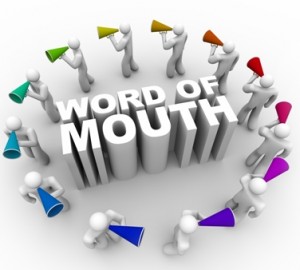First of all what is Electronic word of mouth (eWoM) and how is it different from normal word of mouth promotion?
According to Hennig-Thurau et al. (2004) electronic word of mouth is any positive or negative statement made by potential, actual or former customers about a product or company, which is made available to a multitude of people and institutions via the internet. Essentially it is when a brand is discussed online.
There are two main reasons why companies covet positive word of mouth (WOM); firstly if somebody is recommended a product by a friend they are more likely to purchase it rather than if they saw an advert. And secondly WOM does not carry the same expenditures as other marketing channels (Ahrens, Coyle & Strahilevitz, 2013).
In fact 92% of consumers say they trust recommendations from friends and family over all other forms of advertising, with 70% of consumers saying that they trust online reviews and surveys by other consumers (Nielson, 2012). This means that no matter how good your advertising campaign is, if people are giving you bad reviews you are going to suffer.
The rise of social media has helped with eWoM marketing; Facebook, Twitter, LinkedIn etc.
So what makes eWoM such a powerful tool?
- Large audience
The popularity of Facebook, Twitter, and LinkedIn, amongst other social networking sites, has led to millions of conversations about brands and marketing campaigns online. The more discussion means increased brand awareness.
- Easy to measure
Social media has also made it much easier to measure eWoM, you can see from status updates the public opinion with regards to a product (Jin & Phua, 2014).
- People seek advice online
81% of consumers will now research a product online before they make a purchase (Morrison, 2014). Online reviews are becoming increasingly important for companies they can shape a consumers attitudes towards a product and influence sales.
- Everyone is doing it
79% of the top 100 fortune companies already use Twitter, Facebook, YouTube or corporate blogs to communicate with their customers. 66% have at least one Twitter account which is the preferred platform for companies (Barrenechea, 2013).
- Increased interaction
Social networking sites allows for the humanisation of companies, it allows them to directly connect with the consumer. When the consumer feels valued they will become more brand loyal.
The 4 P’s are the corner stone for any marketer, however with WOM it is important to focus on the 3 E’s. Engage, Equip and Empower.
Engage – Listen to the consumer, interact with them, be a presence within your brand. Orange are a great example of this, in the summer of 2011 their followers had to tweet what their summer plans was with the #thissummer and Orange would capture it and give it a Hollywood voiceover on their blog. This dramatically increased traffic to their site and engaged consumers with the brand.
https://www.youtube.com/watch?v=F7pUqOASpQQ
Equip – Give the consumer a reason to discuss the brand, regularly updates and fresh content are key. Arsenal FC excel at this providing frequent, interesting updates about the club.

Empower – Give consumers different ways to connect with each other and the brand. Walkers recent ‘do us a flavour’ campaign was fantastic as it allowed users to submit entries for a new brand flavour, with the most popular being created by Walkers.
For more information about the 3 E’s, here is a link to marketing specialists, Brent Pohlman, blog http://marketingdirectorblog.com/2014/07/engage-equip-empower/
There’s the age old saying that all publicity is good publicity. This is true with eWoM, even if a bad review is made whilst initially it may be damaging to your brand, you can listen to the comments and make improvements for the next product. Consumers will react positively to your changes and your brand will benefit as a result.
Word of mouth marketing has always been a pivotal tool. Even in the Stone Age it would have been used, cavemen would recommend good hunting sites to each other. It is still as crucial today as it has ever been the only difference now is that as technology is advancing it is becoming more accessible and makes it easier for the consumers to do the marketing for you.
References
Ahrens, J., Coyle, J. & Strahilevitz, M. (2013) Electronic word of mouth: The effects of incentives on e-referrals by senders and receivers, European Journal of Marketing. Vol. 47, Issue 7, pp1034-1051
Barrenechea, F. (2013) The Power of e-Word of Mouth. Adding Social Media to the Marketing Mix, Slide Share. 23 April 2013 [Online] <http://www.slideshare.net/fbarrenecheaf/the-power-of-eword-of-mouth-adding-social-media-to-the-marketing-mix> [Accessed 16 April 2015]
Hennig-Thurar, T., Gwinner, K., Walsh, G. & Gremler, D. (2004) Electronic Word-of-Mouth Via Consumer-Opinion Platforms: What Motivates Consumers to Articulate Themselves on the Internet?, Journal of Interactive Marketing. Vol. 18, Issue 1, pp38-52
Jin, S. & Phua, J. (2014) Following Celebrities’ Tweets About Brands: The Impact of Twitter-Based Electronic Word-of-Mouth on Consumers’ Source Credibility Perception, Buying Intention, and Social Identification With Celebrities, Journal of Advertising. Vol. 43, Issue 2, pp181-195
Morrison, K. (2014) 81% of shoppers conduct online research before buying, Adweek. 28 November 2014 [Online] <http://www.adweek.com/socialtimes/81-shoppers-conduct-online-research-making-purchase-infographic/208527> [Accessed 16 April 2015]
Nielson (2012) Consumer Trust in Online, Social and Mobile Advertising Grows [Online] <http://www.nielsen.com/us/en/insights/news/2012/consumer-trust-in-online-social-and-mobile-advertising-grows.html> [Accessed 16 April 2015]


